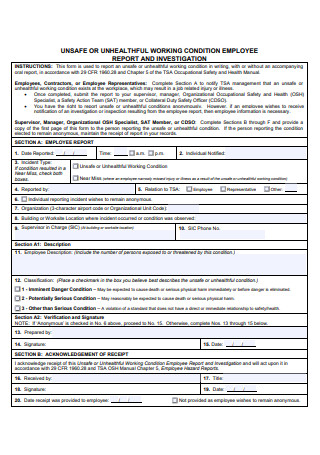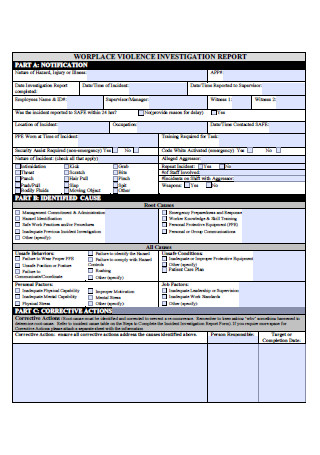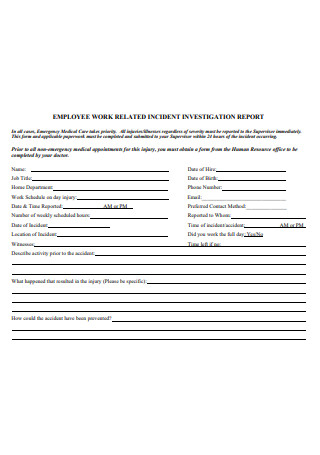3+ Sample Work Investigation Report
FREE Work Investigation Report s to Download
3+ Sample Work Investigation Report
What is a Work Investigation Report?
What is a Work Investigation?
How to Conduct a Work Investigation?
What Makes a Work Investigation Report Effective?
What Should be Included in a Work Investigation Report?
Benefits of a Work Investigation Report
FAQs
What Should a Workplace Investigation Report Include?
How Do You Write a Good Investigation Report?
What are Workplace Investigations?
In a business setting, a work investigation report documents everything with regards to the circumstance which in this article, will be discussed in length. Find out more about what this report could be and download our ready-made samples as we understand how time-consuming, and whether you admit it or not, boring, it can get to create one.
What is a Work Investigation Report?
A work investigation report is a comprehensive written document that is prepared and developed in response to an actual misconduct that occurred in the work environment. If not a significant lapse in ethics, even strong allegations against another that there is wrongdoing being done will warrant an investigation in the workplace.
It is typically prepared when a conclusion to the investigation has been made as it summarizes the entirety of the process and organizes in a well-structured and logical manner all the pertinent information regarding the case and most especially the evidence found to confirm or dismiss the complaint.
As it mostly summarizes the investigation, it has to be written in a way that will easily communicate the findings of the process instead of being as lengthy as the process itself. What we mean by this is that it should not exactly reflect the minute details regarding the chronology of the investigation but rather a general overview of the order of what happened in the process. Case notes is a separate document that depicts the chronological record of the entire investigation and shall be attached to the report which will come in handy if someone were to raise suspicion on the timeliness and how thorough the investigation was conducted.
Similar to a fire investigation report, it should generally reveal how the conclusion was formulated, and what supports it or the lack thereof. Basically, it records the relevant information from when the complaint was first reported down to what occurred especially with the suspected individuals after the investigation is conducted. However, the investigator responsible for writing the report shall be clear about the limitations and should already have outlined the scope of the investigation, in a way that latches it only to the allegation presented, to set and manage the expectations of those who need to be aware of the report.
While you can liken the report to how a personal diary functions, the descriptions used to record the actions that took place during the investigation have to be succinct and objective. At its core, a work investigation report sends the message that a fair, transparent and rigorous process was conducted.
What is a Work Investigation?
A work investigation is launched as per mandated by company policies and the law when a complaint is filed. However, while there is an obvious ‘must’ to start an investigation, it is also conducted to ensure the security of the workplace and that the employees’ rights are protected. Moreover, it is also conducted with the intention to protect the reputation of the company and its shareholders from preventing any form of misconduct, alleged or not, from leaking to the public that therefore might damage the company’s name. Additionally, it also tries to identify which departments in the internal business operations need to recuperate, which employees could need a development plan to improve existing skills and how the work environment, in general, can function better to deliver what is ought to be achieved.
Investigations are first and foremost about gathering information; the cold hard facts to a case, in order to arrive at a conclusion sufficiently supported by the evidence collected. It is conducted to confirm whether or not a misconduct took place, if the suspicions are credible, and if yes to both, it will then identify which laws and regulations are violated for proper consequences to be charged. But in essence, the whole process is basically a continuous, most times lengthy, scouting for evidence which is why it also pays to prepare an investigative work plan to delimit the scope of the investigation.
How to Conduct a Work Investigation?
Complaints and reports of misconduct should be taken seriously by the employers or the company however, there is not much training on how to properly conduct a work investigation unless you have the resources to hire a work investigator. For complaints that do not necessarily need a full-blown investigation, folks from either HR, audit, or compliance, depending on the report, can be tasked to resolve them. Regardless of whether or not they have received training concentrated on launching investigations, there are a few basic practices that they can initially do to handle the situation before it should be decided that an expert opinion is needed.
Step 1: Preliminary Analysis of the Report
The person tasked to handle the report should have conducted a preliminary analysis that will include what can be done to resolve it but more importantly, it should determine if an investigation is required.
Some of the ways to manage the report is by referring the parties involved to consultation, mediation and having personal meetings with them. Borne out of an effective preliminary analysis are also the realistic expectations for everyone involved. In order to determine what steps can be taken to handle the report, the first line of resolution would be to be able to understand the report which requires just enough sensibility and perhaps, even wisdom.
As mentioned, the preliminary analysis should be able to figure out if the report warrants an investigation which is pretty much self-explanatory. There are a few instances when the complaints can be handled without the need of a full-length investigation. Some complaints can be made out of petty grudge or a misunderstanding that can potentially be resolved with counselling, mediation and proper communication. It can also encourage for co-worker evaluations to be conducted and the submission of a monthly performance reports or an annual performance evaluation for consistent assessment of the interrelations within the workplace.
Step 2: Choosing an Investigator
Some allegations can be grave and sensitive that the only obvious route is to conduct an investigation and in the hands of someone who understands the best approaches to resolving the problem especially when all information is still considered ‘allegations’.
In deciding who will spearhead the investigation, the initial considerations are if they will come from the workplace or outside the company. Most would want to seek external help due to a conceived notion that they won’t hold biases if they do not relationships with the employees which is understandable however, it is the duty of an investigator to be objective. Some would also take into consideration the gender of the investigator especially for complaints concerning sexual harassment. Other factors would include the location and the particular language that they speak.
As much as we want to lengthen what the internal unit can do in response to ‘minor’ complaints, there isn’t much except just the first two step, really. Most reports that require an investigation are left in the hands of the investigator who shall perform the following:
- Formulate a Workplace Investigation Plan
- Gather information
- Identify witnesses
- Conduct research
- Collect and document evidence
- Arrive at a conclusion
What Makes a Work Investigation Report Effective?
For a document as invaluable as a work investigation report, it is important that it’s written with the essentials of what should make it effective. For a work investigation report to be deemed good, they must be:
What Should be Included in a Work Investigation Report?
1. Information on the Concerned Parties
The work investigation report should begin with identifying who is involved in the investigation which in most, if not all cases, mean gathering employee information. Key parties are the complainant, the accused and even the investigator. Some of the information for identification include the names, department, role in the investigation, brief job descriptions and their contact information which may include their phone number and emails. Information regarding the investigator include their name, the case number, the date when the report was made and the date when the investigation began.
2. Case Information
In this section, information about the allegation should be identified and explained in detail— who the victim is, the accused, through what medium was the complaint delivered, what the complaint is about and other information necessary to understand the situation.
3. Investigation Plan
The investigator shall already map out a plausible direction that the investigation will take. This includes the goal of the investigation, its limitations and how the gathering of evidence will be collected. For example if it’s through interviews then the investigation plan should include the questions that the investigator will ask the victim, the accused and the witnesses. Basically, this serves as a checklist or a game plan to achieve the best results.
4. Case Notes
Case Notes can be a separate document that records the actions taken during the investigation in a chronological fashion. This is what we mean when we say the report has to capture the entirety of the investigation. Basically it’s the investigation itself just in word form and because the report only has to summarize the full-length of the investigation, it is sometimes recommended that the case notes be an attachment. If the investigator chooses to not separate the case notes, they can choose to briefly report the steps taken throughout the investigation.
5. Interview Summaries
Conduct the interviews with listing them in order in mind. The report shall outline the following information of the interviews:
- Name of the interviewer
- Name of the person being interviewed and their role in the investigation
- Date and location of the interview
6. Interview Reports
In this section of the report, the investigator has to explain how the interview went in brief summaries. In this phase of the investigation, the investigator should be able to determine which information is credible or not and if the interviewees themselves can be considered credible sources. Some other notes in these reports include the turn-taking that took place or words of affirmation and gratitude. Basically, this section should be able to provide a general overview of the incident.
7. Exhibit List
Attach all evidence pertaining to the investigation. These can be interview reports, employee performance evaluation reports, photographs, videos, digital files and emails. Further information will include the date of when the evidence was collected and the location where they were retrieved and are currently kept. Additionally, the names of the people who presented the evidence should also be documented.
8. Recommendations
The report should end with the investigator’s recommendations. Once a thorough review of the data is conducted, the investigator should be able to create the actions that the parties should take. In line with this, a conclusion should have already been laid out.
Benefits of a Work Investigation Report
A properly conducted work investigation that reflects on the report has a number of benefits to the business. Some, we have mentioned in passing while the rest we will outline below:
1. It identifies which disciplinary actions to take
The end goal of a work investigation report is to confirm whether or not the allegations being made against an employee are factual or not. If they are proven to be true, those with authority are likely able to come up with the appropriate disciplinary actions and the extent that they’ll have to go to make it known the gravity of the repercussions when a misconduct is done, like a threat except more apt to the situation and still within ethical standards. There’s nothing wrong with a little intimidation once in a while, yes?
2. It records the investigation.
Because a work investigation report is essentially a summary of the whole incident, it functions as a documentation of the investigation that can be reviewed in the future should a situation arise or if a similar occurrence comes up that is in need of cross-references.
3. It resolves the complaint.
The aim of a workplace investigation is to put a period on the complaint. When the workplace does not foster an environment that allows for proper functioning, it will affect the performance of the whole which is why investigations are conducted to avoid this or if it has already impacted daily operations, the investigation can work to resolve it. Once the validity of the case is confirmed and the accused is taking accountability, the internal affairs can work on improving policies and develop preventive actions.
4. It can magnify loopholes.
How people arrive at the most logical conclusions is not solely because of the investigation but how one studies and interprets it. While you can argue that they’re basically the same thing, the point is really just to say that the constant reviewing of the investigation is what enables its conclusion. Sometimes, investigators get busy and then get so lost in the fact-finding phase of the investigation that some aspects can tend to be overlooked unless you sit down and thoroughly review it all over again. Especially if the investigator is keen on documenting how the investigation is progressing, any gaps to the case will become apparent in the report that a competent investigator will surely catch.
5. It works as an evidence in and of itself.
Keeping a record, especially one that takes into account all the things that occurred works simultaneously as the evidence that proves such a case occurred. It will also prove indispensable if the authenticity of the investigation is challenged, assuming, of course, that the report is just as legitimate.
FAQs
What Should a Workplace Investigation Report Include?
In summary, a workplace investigation report includes information on the complainant, the accused, details of the complaint and a collection of substantial evidence that should confirm or dismiss the complaint. It also contains copies of the interviews conducted with the witnesses. We itemize the main components below:
- Name(s) of the Complainant
- Name(s) of the Accused Department
- Date of Incident
- Date of First Complaint
- Date of When The Investigation was Conducted
- Witnesses
- The Complaint
- Collection of Evidence
- Conclusion
- Recommendations
How Do You Write a Good Investigation Report?
A well-written investigation report is one that can best reiterate the investigation because honestly, that’s basically what workplace investigation is except, it’s more condensed and communicated easier for the possibility of public consumption. It best explains how the conclusions are made from the evidence that were gathered and after extracting information from the witnesses. In addition to that, it is characterized by the following:
What are Workplace Investigations?
Workplace investigations are launched when a complaint filed by an employee is severe enough to warrant it. Most complaints accuse another employee of a misconduct and in order to validate this allegation, a workplace investigation is conducted.




